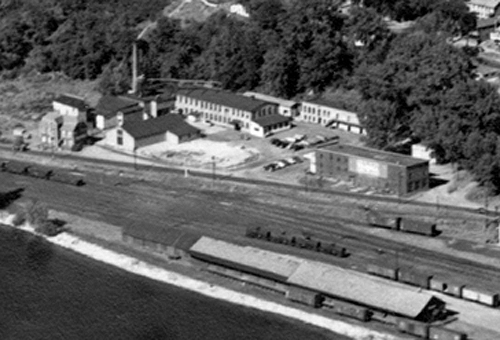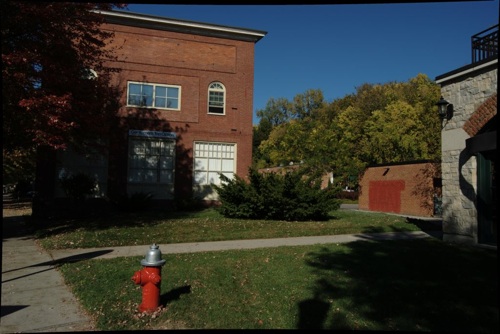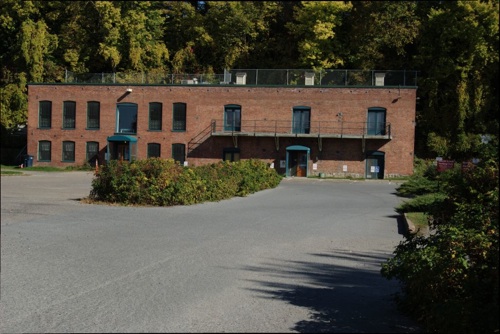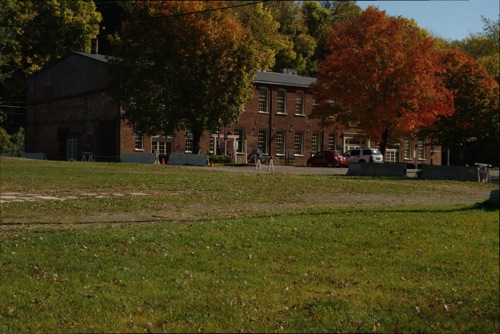Manufacturing sites along the Burlington Waterfront from College Street north
By Gregory S. Jacobs
The area along Burlington's waterfront north of College Street was once the site of a major manufacturing district, producing a vast quantity of goods including lumber, wood products, refrigerators, and packaged meat. Originally the site of the Pioneer Shops, a collection of machine shops built beginning in the 1850s by E.W. Chase, the area grew quickly. J.R. Booth moved part of his enormous lumber operation to the site in 1878, taking advantage of both the ease of water transport from Canada and the growth of rail access granted by the Central Vermont and Rutland railroads.

Over time, a number of other firms moved in, including Morgan Bros., Baldwin Refrigerator, and Northern Provision Company. A series of fires eventually destroyed the original shops, while all but a few of the later buildings were eventually demolished. Those that remain are situated along what is now Lake Street; numbers 86, 102, and 112.

86 Lake Street
The building now known as 86 Lake Street has, over the past century, played a role in housing a number of companies of importance in relation to the history of Burlington's manufacturing industry (Figure 3). Though constructed somewhat later than other historic buildings on Lake Street, 86 is perhaps the most prominent, situated at what was at the time the corner of Lake Street and Bank Street.1

The brick building was originally constructed between 1900 and 1905. Its construction was likely financed by the Northern Provision Company, to be used as cool storage and wholesale space. The Northern Provision Company was a regional merchant who, according to an advertisement in the Burlington City Directory for 1905, traded in "butter, cheese, eggs, beef, pork, lamb, mutton, poultry, canned goods, and produce".2 Their goods also included tobacco and salmon, which were listed among the goods stolen from the company in 1903 by a group of young boys; Howard Bombard, Leonard Pashby, and Eugene Maple. The boys pleaded guilty to the charges brought against them by the Northern Provision Company, Central Vermont railroad, and Burlington Grocery Company for theft and were sentenced to serve three to six months at the correctional facility in Rutland.3
By 1905, the company had grown so much that it was necessary to expand the building. The company paid $2,500 for an addition of 17 feet on its northern face, bringing the total length of the three story structure to 150 feet.4 This addition was likely removed a few years later to make way for a lumber shed owned by J.R. Booth, as it does not appear on insurance maps from 1912.5
The years between the building of the addition and its removal appear to have been difficult for the Northern Provision Company, for by 1912 they had entered into negotiations for the sale of the business to one of their suppliers, the Sulzberger & Sons Company of America.6 Included in the agreement was the transfer of the building's ownership to Sulzberger, who maintained the business for five years before reselling it. During this time, there is little recorded activity, suggesting that Sulzberger used the building primarily as a storehouse and sales location, doing little in the way of packaging or processing their meat at this location.
In 1917 Wilson & Company, a Chicago-based firm that would go on to become one of the largest in the United States, acquired 86 Lake Street.7 This marked the beginning of a sixty-two year period of ownership; by far the longest in its history. The new manager, Samuel E. Pearson, was first in a long line that continued the building's primary use as a meat processing and wholesale packaging site, and would have been present when it was photographed by Louis L. McAllister as part of his Burlington Streets project.
It was also during the course of Wilson & Company's ownership in 1977 that the building, along with others along Lake Street, acquired its first official address; 44.8 What the sudden impetus for numbering the building was is unclear, since the buildings further down Lake Street had been numbered for years prior.
Wilson retained the building until 1979, when they finally closed.9 The firm of McKenzie Products then took over its operation for a few years before moving their operation to Flynn Ave., leaving the old building vacant.10 Fortunately, in 1986 the City of Burlington initiated what it termed an "adaptive reuse" project as part of its effort to reinvigorate the Waterfront District. The old McKenzie building, as it was known, was cited for adaptation to retail and office space in order to attract tenants who, it was hoped, would bring new vitality to Lake Street.11 The street itself was renumbered during the process, giving the building its current address,12 and ownership of the building was transferred to Lake Street Associates. As well as retail and office space, part the building was also fitted out for a hair salon, which is currently occupied by Gentleman's Top Option.13
Notes (86 Lake Street)
2. Burlington City and Winooski Directory, (Burlington, VT: L.P. Waite & Co., 1905).
3. "Sentenced to Rutland," Burlington Weekly Free Press, (Burlington, VT), 12 Feb. 1903.
4. "City News," Burlington Weekly Free Press, (Burlington, VT), 31 Aug. 1905.
5. Insurance Maps of Burlington Vermont, Chittenden County, (New York: Sanborn Map Company, 1912), Sheet 26.
6. "Business Transfer," Burlington Weekly Free Press, (Burlington, Vt.), 15 Aug. 1912.
7. Burlington and Winooski Vermont Directory, (Greenfield, MA: H.A. Manning Co., 1917).
8. Manning's Burlington and South Burlington, Essex Junction, Winooski Directory, (Bellows Falls, VT: H.A. Manning Co., 1977).
9. Manning's Burlington and South Burlington, Essex Junction, Winooski Directory, (Bellows Falls, VT: H.A. Manning Co., 1979).
10. Manning's Burlington and South Burlington, Essex Junction, Winooski Directory, (Bellows Falls, VT: H.A. Manning Co., 1980).
11. City of Burlington Annual Report, (Montpelier, VT: Capital City Press, 1986).
12. Burlington, Vermont City Directory, (Loveland, CO: Johnson Directory Division, 1987).
13. Assessor's Department, "Permit History Report for 86 Lake Street," City of Burlington, http://property.burlingtonvt.gov/PropertyDetails.aspx?a=4863.
102 Lake Street & 112 Lake Street
The history of these two story brick buildings is the among the longest of those remaining on the waterfront (Figures 4 and 5). Both were constructed as part of the new Pioneer Shops. Many of the older shops, originally owned by E.W. Chase and dating from the 1850s, were destroyed in a series of fires.1 112 Lake Street was likely the first to be constructed, although not by much. It was built as part of the new plant owned by J.R. Booth, a lumber baron with broad reach across Canada and the United States. Booth was one of the great industrial barons of the time, rising to prominence from humble origins. Although he started working as a bridge hand for the Central Vermont railroad, by the early 1880s he owned more timber acreage than anyone in Canada, totaling over 1.4 million acres. 2


Booth located an office in Burlington in 1877 and began manufacturing doors at the Pioneer Shops in 1878.3 The company quickly became one of the largest in the city, barely allowing the fire of 1880 to impede its progress (Fig. 6). By 1887, J.R. Booth, along with other lumber companies on the waterfront, had turned Burlington into one of the largest lumber ports in the world. Over the course of a single week that year, the Burlington Free Press reported that over 2,250,000 board feet of lumber was brought in by barge from as far away as Ontario and Quebec.4
Another disastrous fire in 1895 caused extensive damage to the old Pioneer shops, but it apparently spared the two brick buildings from total destruction (Figure 5), perhaps because they are situated in what would have been the northeast corner of the grounds.5 Booth rebuilt quickly, adding new shops and dry houses, which allowed them to lease out the slightly damaged dry house to another small company on the waterfront, Morgan Brothers. Morgan, it seems, had already purchased from J.R. Booth the building which would become 102 Lake Street, and now expanded their glazing and drying operations into 112 Lake Street.6

The Morgan Bros. grew quickly from their origins as door manufacturers, as an advertisement in the Burlington Free Press dated August 5, 1910 indicates: "Piazza Material a Specialty- We specialize on Piazza Material of any conceivable pattern and are always anxious to quote prices from specifications. Finish and excellence of materials considered, our prices will be found very moderate. Write us about building materials, doors, sash, blinds, etc."7
They were equipped not only for the manufacture of wood products, but "leaded art glass and glazing of all kinds."8 With around 30 men in the factory on these various tasks, work continued throughout the year, making Morgan one of the few companies whose operations continued during the winter.
On May 1, 1912, the shops on the waterfront witnessed a major strike, with somewhere around 350 workers leaving their positions at various companies, including J.R. Booth. The primary demand of the strikers was a one-hour reduction in the ten-hour work day, without a reduction in pay. Morgan Bros. acceded to the demands immediately, and thus avoided a strike of their employees, but the other companies held firm. Average pay at the time was about $1.50 per day for adult men, with boys earning slightly less. This was generally the case at all companies on the waterfront at the time.9
Morgan Bros. continued their operation at the Pioneer shops up until 1930, a period when many of the other shops including the original J.R. Booth ceased operation.10 Both buildings were bought up by the T.A. Haigh Lumber Corporation, who moved up from the Pine Street corridor after ceding their land surrounding the Pine Street Barge Canal to the City in the same year.11
Apparently facing financial pressure, Haigh moved its lumber operations from the waterfront after 1983,12 abandoning the building at 102 Lake but retaining ownership of 112. The former eventually passed into the ownership of the Main Street Landing Company, who renovated the building for retail and office space beginning in 1986. In 1993, the interior was again altered and space was given over for use as a daycare, which remains there today under the name Heartworks.13 The other Haigh building, 112, was converted in 1985 for tenants and office space. Two years later further alterations on the first floor resulted in the opening of both a salon and a restaurant. The salon is now closed but the restaurant, originally known as Isabel's, still exists. It is now San Sai Japanese Restaurant.14
Notes (102 Lake Street & 112 Lake Street)
2."Vermont News," Vermont Phœnix (Brattleboro, VT), 03 Feb. 1882.
3. Burlington City Directory (Burlington, VT: The Free Press Association, 1877).
4. "City and Vicinity," Burlington Weekly Free Press (Burlington, VT), 22 July 1887.
5. "Risen From The Ashes," Burlington Weekly Free Press (Burlington, VT), 19 Dec. 1895.
6. Insurance Maps of Burlington Vermont, Chittenden County (New York: Sanborn Map Company, 1912), Sheet 26.
7. Advertisement, Middlebury Register (Middlebury, VT), 05 Aug. 1910.
8. Advertisement, Burlington Weekly Free Press (Burlington, VT), 18 May 1905.
9. "Strike Along Lake Front," Burlington Weekly Free Press (Burlington, VT), 2 May 1912.
10. Manning's Burlington, Winooski, and Essex Junction Directory (Springfield, MA: H.A. Manning Co., 1930).
11. City of Burlington, Grant of Environmental Restrictions and Right of Access, accessed Oct. 15, 2013, http://www.epa.gov/region1/superfund/sites/pinestreet/262814.pdf.
12. Manning's Burlington and South Burlington, Essex Junction, Winooski Directory (Bellows Falls, VT: H.A. Manning Co., 1983).
13. Assessor's Department, "Permit History Report for 102 Lake Street," City of Burlington, http://property.burlingtonvt.gov/GeneratedReports/17e3c04b-d67d-4b09-97ba-4ad1a43bb5a6.pdf.
14. Assessor's Department, "Permit History Report for 112 Lake Street," City of Burlington, http://property.burlingtonvt.gov/GeneratedReports/d485330b-fe4a-4fcb-8e11-70c0f278cb12.pdf.